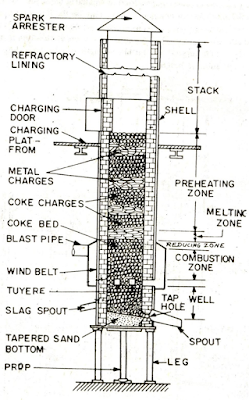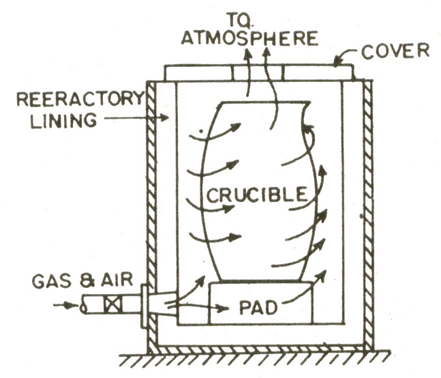a) Metal Melting and Casting
b) Inspection of Casting and Casting Defects
All type of metal melting furnace can be used for foundry operations. However, foundry requirements are some times unique and one or another type of furnace may be best for a particular operation.
The choice of furnace may be detailed by:
2. Relative average cost of maintenance and repair.
3. Base cost of operation.
4. Availability and relative cost of various fuels.
5. Cleanliness and noise level in operation.
6. Melting efficiency in particular the speed on melting.
7. Degree of control.
8. Composition and melting temperature of metal.
Cupolas: The cupola is the standard melting unit of the iron foundry. Cupola melting is generally cheapest netgid. Fuel of the cupola is preferably a good grade. Low sulpher coke anthracite coal may also be used. The furnace is charged at frequent intervals with proportional amounts of coke lime stone and metal.
It consists of a 20-35 ft refractory lined cylindrical steel stack resting on an iron bottom plate which is supported by four steel legs.
It has some part, tuyeres- superheating zone, melting zone, preheating zone stack charging door is 10-20 ft above the bottom doors. Tuyeres through which the air blast enters the cupola are located some 10-20 in above the bottom doors.
Figure-18: Cross-section through a cupola
Crucible furnace: The crucible furnace is the oldest type of melting furnace. This crucible was placed in a pit dug into the ground. Wood or coke was packed around the crucible and ignited. But today coke oil or gas can be used as fuel. All non-ferrous metal are melted is pit furnace in coke fired units and cast iron can be melted if enough time allowed.
The cupola is a melting pot of a clay and graphite composition, which is molded to a standard shape and size from 1 to 400. The crucible number represents its approximate capacity in pound of aluminum.
Open hearth furnace: Open hearth furnace is used by a few large foundries and all shops producing ingots. The melting rate is relatively slow depending upon the furnace size 10 to 200 tons metal may be melted at one time oil and gas used as fuel.
INSPECTION OF CASTING –DEFECTIVE CASTING AND CAUSES OF DEFECTS
The degree of care required in the inspection of casting depends upon the uses for which the castings are made. Most foundries inspect for external defects only, that is, if no noticeable imperfections are present, the castings are considered good. Some castings have hidden or internal defects that become visible only when the castings are machined. Frequently, however, these concealed defects will never be discovered until the casting is scrapped and broken up to be re-melted, having given satisfactory service meanwhile. Depending on the inspection for external imperfections, or machining away the defective portion, is not sufficient. In such cases the inspections are often made by using an X-ray machine.
CAUSES OF DEFECTIVE CASTINGS
1) Blow holes: Blow holes in castings are very common and result from many different causes, as follows:1. High moisture content in molding sand,
2. Low permeability of sand.
3. Hard ramming of sand.
4. Defective gating system.
5. Improper venting of sand.
2) Cold shuts or misruns: Misruning castings results from the following:
1. Pouring too cold metal into the mold.
2. Using either too few or small gates.
3. Pouring metal into the mold too slowly.
3) Cracked castings: Some castings are likely to crack while cooling in the mold and others after they come from the molds. Owing usually to the following causes:
1. Poorly designed casting, which is those having too light and too heavy sections.
2. Allowing the light section of a casting to coal before the heavy section.
3. Cracks in castings can be prevented by removing sand from the heavy but allowing it to remain on the light section until the casting is cold.
4) Crushed castings: These are often caused by the following:
1. If the sand in any cope does not fit the sand in the drag, when the mold is closed it may cause a crushed casting.
2. If a dry sand core that is too large for the core rings is placed in a mold, it will causes a crushed casting
3. If a mold clamped too hard, it can cause a crushed castings.
5) Hard casting: Some gray iron castings are too hard to be machined. Whereas others machine easily, some causes of hard castings are as follows:
1. Coatings small gray iron castings too fast will make them hard.
2. Having molding sand too wet may also make small gray iron castings too hard.
3. Using iron too low in silicon.
4. Using iron too high in sulpher or manganese.
5. Metal boiling in the ladle when the mold is poured is likely to make casting hard.
6) Porosity: Porosity in castings is usually found on the inside of the heavy sections and is casted by metal being drag from the heavy sections while the light sections are solidifying. In some cases feeders on castings help to prevent porosity, but in other cases are not much help. Some causes of the porosity are as follows:
1. Poor design as to metal thickness in the castings.
2. Having metal too hot when pouring the mold.
3. In gray castings, using metal too high in silicon or phosphorus.
1. Making the mold from sand that is too coarse.
2. Having the molding sand too damp when making the mold.
3. Pouring metal into mold that is rammed to soft.
8) Shifts: Frequently castings have shifts that disqualify them for used. Most shifts, however, can be prevented easily if the molder pays close attention to the following:
1. Pins on flask should fit smoothly when the mold is made. They should be neither loose no tight.
2. When a snap flask mold, with the flask removed, is carried from the molding bench to the mold should be kept level because the cope may slip on the drag causing a shift in the casting.
3. When split patterns are used, the dowel should fit in the dowel pinholes.
4. Slip jackets put over nap flask molds in a careless manner also cause shifts.
1. Ramming is too soft.
2. Defecting ramming of mold.
3. Pressure of pouring metal is too high.


